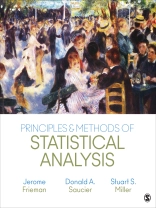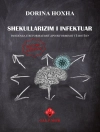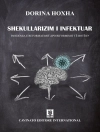This unique intermediate/advanced statistics text uses real research on antisocial behaviors, such as cyberbullying, stereotyping, prejudice, and discrimination, to help readers across the social and behavioral sciences understand the underlying theory behind statistical methods. By presenting examples and principles of statistics within the context of these timely issues, the text shows how the results of analyses can be used to answer research questions. New techniques for data analysis and a wide range of topics are covered, including how to deal with ’messy data’ and the importance of engaging in exploratory data analysis.
Innehållsförteckning
Preface
About the Authors
Prologue
PART I • GETTING STARTED
Chapter 1: The Big Picture
Models
The Classical Statistical Model
Designing Experiments and Analyzing Data
Summary
Questions Raised by the Use of the Classical Statistical Model
Conceptual Exercises
Chapter 2: Examining Our Data: An Introduction to Some of the Techniques of Exploratory Data Analysis
Descriptive Statistics
Histograms
Exploratory Data Analysis
Quantile Plots
Stem-and-Leaf Displays
Letter-Value Displays
Box Plots
Did My Data Come From a Normal Distribution?
Why Should We Care About Looking at Our Data?
Summary
Conceptual Exercises
PART II • THE BEHAVIOR OF DATA
Chapter 3: Properties of Distributions: The Building Blocks of Statistical Inference
The Effects of Adding a Constant or Multiplying by a Constant
The Standard Score Transformation
The Effects of Adding or Subtracting Scores From Two Different Distributions
The Distribution of Sample Means
The Central Limit Theorem
Averaging Means and Variances
Expected Value
Theorems on Expected Value
Summary
Conceptual Exercises
PART III • THE BASICS OF STATISTICAL INFERENCE: DRAWING CONCLUSIONS FROM OUR DATA
Chapter 4: Estimating Parameters of Populations From Sample Data
Statistical Inference With the Classical Statistical Model
Criteria for Selecting Estimators of Population Parameters
Maximum Likelihood Estimation
Confidence Intervals
Beyond Normal Distributions and Estimating Population Means
Summary
Conceptual Exercises
Chapter 5: Resistant Estimators of Parameters
A Closer Look at Sampling From Non-Normal Populations
The Sample Mean and Sample Median Are L-Estimators
Measuring the Influence of Outliers on Estimates of Location and Spread
?-Trimmed Means as Resistant and Efficient Estimators of Location
Winsorizing: Another Way to Create a Resistant Estimator of Location
Applying These Resistant Estimators to Our Data
Resistant Estimators of Spread
Applying These Resistant Estimators to Our Data (Part 2)
M-Estimators: Another Approach to Finding Resistant Estimators of Location
Which Estimator of Location Should I Use?
Resampling Methods for Constructing Confidence Intervals
A Final Caveat
Summary
Conceptual Exercises
Chapter 6: General Principles of Hypothesis Testing
Experimental and Statistical Hypotheses
Estimating Parameters
The Criterion for Evaluating Our Statistical Hypotheses
Creating Our Test Statistic
Drawing Conclusions About Our Null Hypothesis
But Suppose H0 Is False?
Errors in Hypothesis Testing
Power and Power Functions
The Use of Power Functions
p-Values, a, and Alpha (Type I) Errors: What They Do and Do Not Mean
A Word of Caution About Attempting to Estimate the Power of a Hypothesis Test After the Data Have Been Collected
Is It Ever Appropriate to Use a One-Tailed Hypothesis Test?
What Should We Mean When We Say Our Results Are Statistically Significant?
A Final Word
Summary
Conceptual Exercises
PART IV • SPECIFIC TECHNIQUES TO ANSWER SPECIFIC QUESTIONS
Chapter 7: The Independent Groups t-Tests for Testing for Differences Between Population Means
Student’s t-test
Distribution of the Independent Groups t-Statistic when H0 Is True
Distribution of the Independent Groups t-Statistic When H0 Is False
Factors That Affect the Power of the Independent Groups t-Test
The Assumption Behind the Homogeneity of Variance Assumption
Graphical Methods for Comparing Two Groups
Suppose the Population Variances Are Not Equal?
Standardized Group Differences as Estimators of Effect Size
Robust Hypothesis Testing
Resistant Estimates of Effect Size
Summary
Conceptual Exercises
Chapter 8: Testing Hypotheses When the Dependent Variable Consists of Frequencies of Scores in Various Categories
Classifying Data
Testing Hypotheses When the Dependent Variable Consists of Only Two Possibilities
The Binomial Distribution
Testing Hypotheses About the Parameter p in a Binomial Experiment
The Normal Distribution Approximation to the Binomial Distribution
Testing Hypotheses About the Difference Between Two Binomial Parameters (p1 – p2)
Testing Hypotheses in Which the Dependent Variable Consists of Two or More Categories
Summary
Conceptual Exercises
Chapter 9: The Randomization/Permutation Model: An Alternative to the Classical Statistical Model for Testing Hypotheses About Treatment Effects
The Assumptions Underlying the Classical Statistical Model
The Assumptions Underlying the Randomization Model
Hypotheses for Both Models
The Exact Randomization Test for Testing Hypotheses About the Effects of Different Treatments on Behavior
The Approximate Randomization Test for Testing Hypotheses About the Effects of Different Treatments on Behavior
Using the Randomization Model to Investigate Possible Effects of Treatments
Single-Participant Experimental Designs
Summary
Conceptual Exercises
Additional Resources
Chapter 10: Exploring the Relationship Between Two Variables: Correlation
Measuring the Degree of Relationship Between Two Interval-Scale Variables
Randomization (Permutation) Model for Testing Hypotheses About the Relationship Between Two Variables
The Bivariate Normal Distribution Model for Testing Hypotheses About Population Correlations
Creating a Confidence Interval for the Population Correlation Using the Bivariate Normal Distribution Model
Bootstrap Confidence Intervals for the Population Correlation
Unbiased Estimators of the Population Correlation
Robust Estimators of Correlation
Assessing the Relationship Between Two Nominal Variables
The Fisher Exact Probability Test for 2 x 2 Contingency Tables With Small Sample Sizes
Correlation Coefficients for Nominal Data in Contingency Tables
Summary
Conceptual Exercises
Chapter 11: Exploring the Relationship Between Two Variables: The Linear Regression Model
Assumptions for the Linear Regression Model
Estimating Parameters With the Linear Regression Model
Regression and Prediction
Variance and Correlation
Testing Hypotheses With the Linear Regression Model
Summary
Conceptual Exercises
Chapter 12: A Closer Look at Linear Regression
The Importance of Looking at Our Data
Using Residuals to Check Assumptions
Testing Whether the Relationship Between Two Variables Is Linear
The Correlation Ratio: An Alternate Way to Measure the Degree of Relationship and Test for a Linear Relationship
Where Do We Go From Here?
When the Relationship Is Not Linear
The Effects of Outliers on Regression
Robust Alternatives to the Method of Least Squares
A Quick Peek at Multiple Regression
Summary
Conceptual Exercises
Chapter 13: Another Way to Scale the Size of Treatment Effects
The Point Biserial Correlation Coefficient and the t-Test
Advantages and Disadvantages of Estimating Effect Sizes With Correlation Coefficients or Standardized Group Difference Measures
Confidence Intervals for Effect Size Estimates
Final Comments on the Use of Effect Size Estimators
Summary
Conceptual Exercises
Chapter 14: Analysis of Variance for Testing for Differences Between Population Means
What Are the Sources of Variation in Our Experiments?
Experimental and Statistical Hypotheses
Estimating Variances
When There Are More Than Two Conditions in Your Experiment
Assumptions for Analysis of Variance
Testing Hypotheses About Differences Among Population Means With Analysis of Variance
Factors That Affect the Power of the F-Test in Analysis of Variance
Relational Effect Size Measures for Analysis of Variance
Randomization Tests for Testing for Differential Effects of Three or More Treatments
Using ANOVA to Study the Effects of More Than One Factor on Behavior
Partitioning Variance for a Two-Factor Analysis of Variance
Testing Hypotheses With Two-Factor Analysis of Variance
Testing Hypotheses About Differences Among Population Means With Analysis of Variance
Dealing With Unequal Sample Sizes in Factorial Designs
Summary
Conceptual Exercises
Chapter 15: Multiple Regression and Beyond
Overview of the General Linear Model Approach
Regression
Simple Versus Multiple Regression
Multiple Regression
Types of Multiple Regression
Interactions in Multiple Regression
Continuous x Continuous Interactions
Categorical x Continuous Interactions
Categorical x Categorical Interactions: ANOVA Versus Regression
Summary
Conceptual Exercises
Epilogue
Appendices
A. Some Useful Rules of Algebra
B. Rules of Summation
C. Logarithms
D. The Inverse of the Cumulative Normal Distribution
E. The Unit Normal Distribution
F. The t-Distribution
G. The Fisher r to zr Transformation
H. Critical Values for F With Alpha = .05
I. The Chi Square Distribution
References
Index
Om författaren
Jerome Frieman earned his Ph D from Kent State University in Ohio. He has been at Kansas State University since 1968. Over the course of his career, he engaged in research on operant conditioning in pigeons, rats, and dwarf hamsters; Pavlovian conditioning in rats; social learning in dwarf hamsters; and extraordinary memory in a human participant. He is the author of Learning and Adaptive Behavior and co-author of Memory Search by a Memorist.












